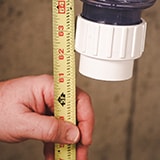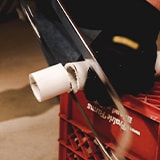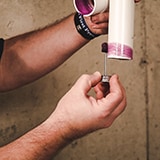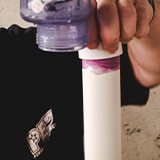
A Step By Step Guide to Cutting and Gluing PVC Pipe
If you're considering installing your own sump pump and haven't worked with PVC pipe, you've come to the right page.
Many people consider cutting and gluing PVC pipe one of the more difficult parts of installing a pump. Even if you've never worked with PVC pipe before, you'll be surprised to know how easy it is to work with once you have all the parts and tools necessary for the job.
Tools For Cutting PVC Pipe
There are only a few simple tools you need in order to cut and glue PVC piping. They are:
- a hacksaw or pipe cutter
- sandpaper or a knife for deburring
- PVC primer
- PVC cement
- permanent marker
- measuring tape
- a raised surface to cut (like a crate)
Below is our video on how to install a sump pump, highlighting the section about cutting and gluing PVC pipe.
Schedule 40 PVC Pipe Dimensions Chart
It helps to understand the dimensions of the PVC pipe you are using. To make it easy, we have provided a chart below for reference on standard pipe sizing.
How to Cut and Glue PVC Pipe
Below are the steps for cutting PVC pipes the right way. One important thing to call out is to make sure you measure correctly, and once you have the pipe and fitting connected, you need to twist the pipe to make sure the cement and primer adhere together properly.
Step 1: Take Measurements
 Measure the length of the PVC pipe you'll need to cut and mark it on the pipe. Remember to measure twice and cut once—you can always take more off, but you can't put length back on.
Measure the length of the PVC pipe you'll need to cut and mark it on the pipe. Remember to measure twice and cut once—you can always take more off, but you can't put length back on.
Step 2: Place Pipe on Raised Surface
Using your crate, box, or any other stable raised surface, lay your PVC pipe on it with the line you need to cut hanging slightly off the edge. One hand will be used to cut the pipe, and the other should hold down the pipe on the surface to keep it level and prevent it from moving.
Step 3: Cut the Pipe
 Using your hacksaw, begin sawing through the line and attempt to cut as straight a line as possible. Do not let the piping tip upward or downward while cutting, or else the final edge may not be straight. If the cut is crooked, the pipe may leak or not fit properly into the fitting.
Using your hacksaw, begin sawing through the line and attempt to cut as straight a line as possible. Do not let the piping tip upward or downward while cutting, or else the final edge may not be straight. If the cut is crooked, the pipe may leak or not fit properly into the fitting.
Step 4: Deburr the Pipe's Edge
Deburring is a fancy way to say "smooth out the edges." Using sandpaper or a utility knife, scrape the edges of the PVC pipe to smooth out the cut until the edge is perfectly smoothed over. This will ensure a clean connection when it is attached to the fitting.
Step 5: Priming the PVC Pipe
 Prime the inside of the fitting and the outer edge of the piping using the standard PVC primer. More than likely, it will be purple and comes with a brush to apply the primer to your pipe and connectors. Just be aware that this primer can stain skin and clothing, so apply with caution.
Prime the inside of the fitting and the outer edge of the piping using the standard PVC primer. More than likely, it will be purple and comes with a brush to apply the primer to your pipe and connectors. Just be aware that this primer can stain skin and clothing, so apply with caution.
Step 6: Gluing the PVC Pipe
Take your PVC cement (clear liquid) and apply it over the same area you covered with the PVC primer. A chemical reaction will take place once the glue is applied on top of the primer, so once the cement is applied, move quickly.
Step 7: Bond the PVC Pipe and Fitting
 The trick to ensuring a solid bond between the PVC pipe and your fitting is to twist the pipe inside the fitting a quarter-turn and hold for about fifteen to twenty seconds in order to activate the chemical reaction that will bond the cement and primer together. If you don't twist after putting the two together, the bond may not hold and your pipe may leak.
The trick to ensuring a solid bond between the PVC pipe and your fitting is to twist the pipe inside the fitting a quarter-turn and hold for about fifteen to twenty seconds in order to activate the chemical reaction that will bond the cement and primer together. If you don't twist after putting the two together, the bond may not hold and your pipe may leak.
How to Install A Sump Pump System
Now that you know how to cut and glue PVC piping, installing a sump pump is easier than ever. Click on the link below to access our step-by-step guide on how to install a sump pump. Don't worry about calling the plumber; use our guide instead and learn how to install one yourself!
![]() NEXT: Sump Pump Installation Guide
NEXT: Sump Pump Installation Guide



